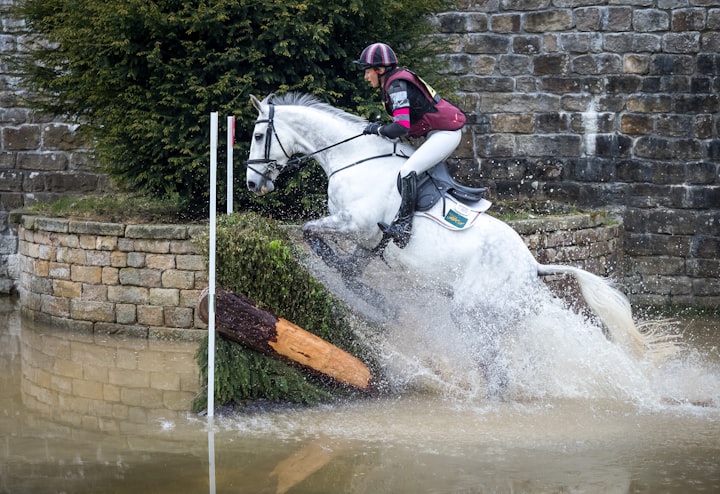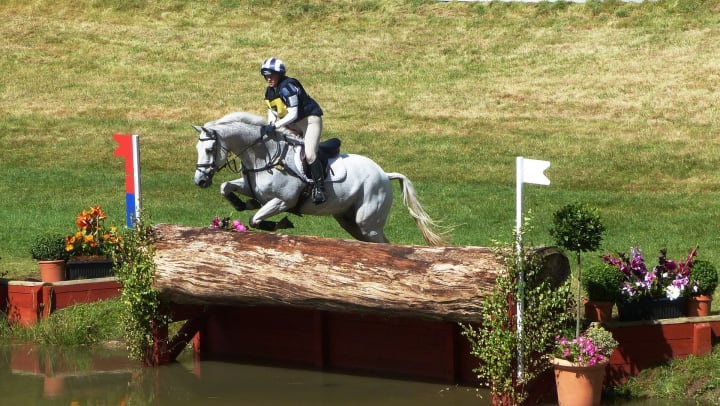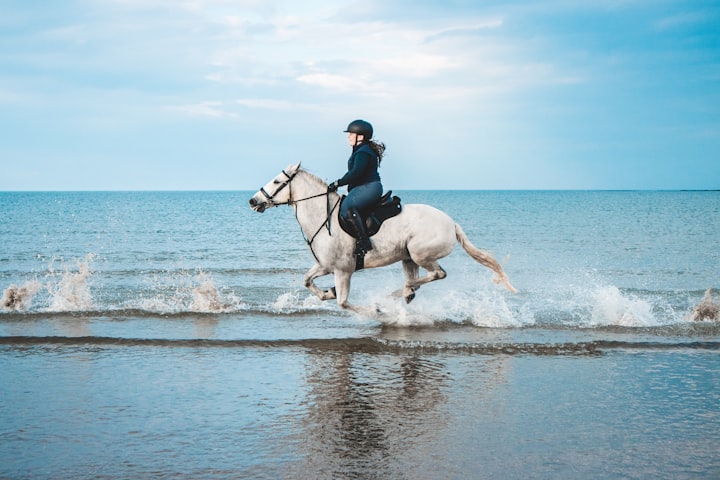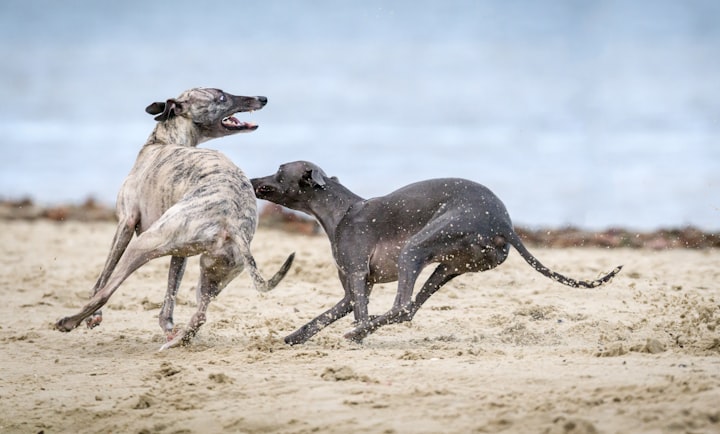The Hidden Dangers of Equestrian Sports: Why Eventing May Be Worse for Horses than Racing
From catastrophic injuries to rotational falls and welfare issues, learn why eventing may be more dangerous for horses than racing

Equestrian sports, such as racing and eventing, are popular around the world and attract fans and competitors alike. However, behind the glamour and excitement of these sports lies a darker side - one that involves serious risks to the welfare and safety of the horses involved.
While both racing and eventing carry inherent risks, recent research suggests that eventing may be more dangerous for horses than racing. From catastrophic injuries to rotational falls and welfare issues, several factors make eventing a potentially hazardous sport for horses.

Racing vs Eventing
Firstly, it is essential to understand the nature of both events. Horse racing involves a horse running at high speeds around a track, usually for a distance of 1-2 miles. The horse's physical abilities are tested, and the first horse to cross the finish line wins the race. In contrast, eventing is a competition that includes three different phases: dressage, cross-country, and show jumping. The event usually spans three days, and the horse and rider must complete all three phases successfully to win.
The dressage phase involves the horse and rider performing a series of precise movements and patterns in an arena. The cross-country phase is a gruelling test of endurance and stamina where the horse and rider navigate a challenging course of fences, ditches, and water obstacles. The show jumping phase is a timed event where the horse and rider jump a series of fences in an arena.
The primary reason why eventing is worse for horse welfare than horse racing is that the event is more physically demanding on the horse. While both sports involve exertion, the nature of eventing is more intense and prolonged. The cross-country phase of eventing can last up to 11 minutes, with the horse galloping over more than 30 obstacles. This puts a tremendous strain on the horse's heart, lungs, and muscles.
Moreover, the horses that participate in eventing are often asked to jump over obstacles that are much larger and more challenging than those found in horse racing.

Catastrophic Injuries in Racing vs. Eventing
Racing is known to have a higher incidence of catastrophic injuries, which are injuries that result in euthanasia or retirement from racing. According to the Jockey Club's Equine Injury Database, the incidence of catastrophic injuries in Thoroughbred racing in the United States was 1.68 per 1,000 starts in 2020. This is a decrease from previous years, but still higher than the rate of catastrophic injuries in eventing.
However, eventing also has its own set of risks and injury patterns. According to a study published in the Equine Veterinary Journal, the overall injury rate in eventing competitions was 5.7 injuries per 1,000 starts, with a fatality rate of 0.58 per 1,000 starts. The majority of injuries in eventing were minor, such as cuts or bruises, but there were also a significant number of serious injuries, including fractures and tendon injuries.

Rotational Falls in Eventing
One of the most significant risks in eventing is the risk of rotational falls. A rotational fall is a type of fall that can occur in horseback riding, particularly during the cross-country phase of eventing competitions. It is considered one of the most dangerous and potentially fatal types of falls for both horses and riders.
In a rotational fall, the horse approaches a fence and either misjudge the distance or speed or makes a mistake in the jump itself, resulting in the horse hitting the fence or landing awkwardly. This causes the horse to trip and fall forward, flipping over itself, and landing on its back or side. The rider is often thrown clear, but the horse can be seriously injured or killed.
The force of a rotational fall can cause severe injuries to the horse, including fractures, internal injuries, and head trauma. The impact of the fall can also cause the horse's organs to shift, potentially causing further damage or even death.
One of the most significant dangers of a rotational fall is that the horse can become trapped underneath the fence, unable to free itself. This can lead to further injuries or death, as the horse struggles to escape and becomes more entangled in the fence.
Even if the horse manages to free itself, the psychological trauma of a rotational fall can have long-lasting effects on the horse. Horses that have experienced a rotational fall may become nervous or anxious when approaching jumps or may refuse to jump altogether. This can severely impact their performance and quality of life.
Despite efforts to make eventing safer for horses, including improvements in fence design and course construction, rotational falls continue to occur. The danger of rotational falls highlights the importance of horse welfare in equestrian sports and the need for continued efforts to reduce the risks and ensure the safety of both horse and rider.
A study by the British Eventing organization found that the incidence of rotational falls in eventing was 1.4 per 1,000 starts, with a fatality rate of 0.19 per 1,000 starts. This highlights the potentially life-threatening nature of rotational falls and the need for continued efforts to improve safety measures in eventing.

Solid Cross-Country Jumps
Solid cross-country jumps are obstacles made of solid materials such as logs, stone walls, or fences. They are commonly used in eventing competitions during the cross-country phase, where the horse and rider must navigate a course of challenging jumps.
While solid jumps are visually impressive and can be exciting for spectators, they pose a significant danger to the horse and rider. The primary danger of solid jumps is the risk of serious injury if the horse fails to clear the jump or hits it with too much force.
If the horse fails to clear a solid jump, it can result in a rotational fall, as described previously. The horse can become trapped underneath the fence, or the impact of the fall can cause severe injuries such as fractures, internal injuries, or head trauma. These injuries can be life-threatening or require long-term rehabilitation and recovery.
Even if the horse clears a solid jump successfully, it can still sustain injuries. Horses that jump solid obstacles with too much force can injure their legs or strain their muscles, ligaments, or tendons. This can result in lameness or long-term damage that can affect the horse's performance and quality of life.
Moreover, solid cross-country jumps can be particularly dangerous in wet or slippery conditions, as the horse can slip or lose traction when jumping, increasing the risk of falls and injuries. The design of the jump can also impact the level of danger, with jumps that have sharp or jagged edges posing a greater risk to the horse than jumps with smooth or rounded edges.
To address these dangers, eventing organizations have taken steps to make solid cross-country jumps safer for horses. This includes designing jumps with more forgiving materials, such as brushes or frangible pins, which can break away upon impact and reduce the risk of injury. They have also worked on the construction of jumps to create a more forgiving shape, with rounded or sloping edges that can lessen the impact on the horse if they make contact.

Welfare Issues in Eventing
In addition to the physical risks involved in eventing, several welfare issues can arise for horses. These include injuries, overexertion, equipment and training, environmental factors, and transport and stabling.
Some examples of welfare issues in eventing are:
- Injuries: As mentioned earlier, eventing has a high risk of injuries, especially in the cross-country phase. Horses can sustain serious injuries such as fractures, tendon or ligament damage, and head trauma. Even minor injuries such as cuts and bruises can impact the horse's welfare if not treated promptly and appropriately.
- Overexertion: Cross-country courses can be long and physically demanding, especially for horses that are not adequately conditioned. Overexertion can lead to fatigue, dehydration, and metabolic imbalances, which can impact the horse's health and performance. Horses that are pushed beyond their physical limits can suffer from exhaustion, heat stroke, or collapse, which can be life-threatening.
- Equipment and training: The equipment used in eventing, such as saddles, bridles, and bits, can cause discomfort or pain to the horse if not fitted properly or used correctly. Training methods that rely on force or punishment can also cause stress, fear, and pain, which can impact the horse's welfare and trust in its rider.
- Environmental factors: The weather and course conditions can also impact the horse's welfare in eventing. Wet or slippery footing can increase the risk of falls and injuries, while extreme heat or cold can cause stress and dehydration. Course designs that are too challenging or unsafe can also put the horse at risk and impact their welfare.
- Transport and stabling: Competing in eventing often involves travelling long distances and staying in unfamiliar stabling facilities. Transport and stabling can cause stress, fatigue, and exposure to infectious diseases if proper biosecurity measures are not followed. Horses that are housed in poor conditions, such as overcrowding or unsanitary stabling, can also suffer from respiratory or digestive problems.
To address these welfare issues, eventing organizations have implemented various measures such as course design and safety standards, veterinary inspections, and education programs for riders and trainers. It's essential to continue to prioritize the welfare of the horse in eventing and take steps to ensure that they are treated with care and respect at all times.
Racing vs Eventing Statistics
It's challenging to compare the safety of racing and eventing directly, as the two sports have different injury patterns and risk factors. However, we can look at available statistics and research to gain a better understanding of the risks involved in each sport.
Racing is known to have a higher incidence of catastrophic injuries, which are injuries that result in euthanasia or retirement from racing. According to the Jockey Club's Equine Injury Database, the incidence of catastrophic injuries in Thoroughbred racing in the United States was 1.68 per 1,000 starts in 2020. This is a decrease from previous years, but still higher than the rate of catastrophic injuries in eventing.
Eventing also has its own set of risks and injury patterns. According to a study published in the Equine Veterinary Journal, the overall injury rate in eventing competitions was 5.7 injuries per 1,000 starts, with a fatality rate of 0.58 per 1,000 starts. The majority of injuries in eventing were minor, such as cuts or bruises, but there were also a significant number of serious injuries, including fractures and tendon injuries.
One of the most significant risks in eventing is the risk of rotational falls, as described earlier. A study by the British Eventing organization found that the incidence of rotational falls in eventing was 1.4 per 1,000 starts, with a fatality rate of 0.19 per 1,000 starts. This highlights the potentially life-threatening nature of rotational falls and the need for continued efforts to improve safety measures in eventing.
It's important to note that both racing and eventing have made significant efforts to improve safety and reduce the risk of injury to horses. Racing has implemented measures such as improved track surfaces, stricter medication rules, and better veterinary oversight, while eventing has focused on improving course design, fence construction, and safety equipment for riders and horses.

What to take away
While both horse racing and eventing come with inherent risks to the safety and welfare of the horses involved, the evidence suggests that cross-country eventing is more dangerous.
According to statistics, eventing has a higher incidence of horse fatalities and catastrophic injuries than horse racing. Additionally, the solid cross-country jumps used in eventing can be unforgiving and lead to serious injuries if the horse misjudges the jump or falls. Furthermore, the intense physical demands of eventing, coupled with the length and intensity of the competition, can also place significant stress on the horse's body and mind.
In comparison, horse racing is subject to strict regulations and safety standards that are enforced by governing bodies. These regulations include restrictions on the use of drugs, safety equipment for both horse and rider and mandatory veterinary inspections.
While both horse racing and eventing have taken steps to improve the safety and welfare of horses, it's clear that more needs to be done. As fans and participants of equestrian sports, it's our responsibility to advocate for the well-being of horses and push for meaningful change in the industry.
Ultimately, whether we're talking about horse racing or eventing, we must remember that the horses involved are sentient beings that deserve our respect and protection. By working together to address the issues facing horses in equestrian sports, we can ensure a brighter future for these incredible animals.
About the Creator
Jane Smith
I'm a horsewoman who is angry about everything that is wrong with the horse world in the UK.
I am the woman who is not afraid to say what she thinks, and I'm not going to stop until the world is a better place for horses.






Comments
There are no comments for this story
Be the first to respond and start the conversation.